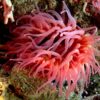Under certain conditions microbial communities can grow and thrive, even in places that are seemingly uninhabitable. This is the case at inactive hydrothermal vents on the sea floor. An international team that includes researchers from MARUM—Center for Marine Environmental Sciences at the University of Bremen, is presently working to accurately quantify how much inorganic carbon can be bound in these environments.
With its high pressure, darkness, and nutrient deficiency, the deep sea is generally not a hospitable place. But in the presence of heat and a rich influx of energy-rich fluids, as is the case at active hydrothermal vents, numerous fish, shellfish, and microorganisms are able to settle there. But what happens to these biotic communities when the source of hot fluids is exhausted?
The chimneys form over long time periods when seawater seeps through cracks into the Earth’s crust, is warmed there, then dissolves and takes up minerals on its way back up to the ocean floor. This hot, mineral-rich, and often smokey water seeks the most pervious path through the Earth’s crust and encounters cold, oxygen-rich water at the sea floor.
This results in the precipitation of minerals, which are deposited as chimneys. These hydrothermal vents are energy-rich habitats based on chemosynthesis where microorganisms from the base of the food webs. Depending on the region, chimneys at hydrothermal seeps contain minerals like copper, zinc, gold, or silver. As a result, there is a growing interest in exploiting inactive smokers in deep-sea mining activities.
When the flow of mineral-rich fluids dries up, the black smokers become inactive. Larger organisms migrate away to the next vent, but the microbial communities have ways to adapt to the new conditions.
“Even forty years after the discovery of the first hydrothermal fields, we constantly learn new things about how these ecosystems work,” says Dr. Florence Schubotz of MARUM, “particularly relating to the amount of CO2 bound up in inactive smokers, but also with regard to the volume of microbial life, its activity, and rates of production.”
Determining how densely inactive smokers are colonized is the central focus of a research project in which Schubotz is working. The work involves sampling at the exact area where the first hydrothermal vents were discovered in the eastern Pacific around four decades ago.
“The initial results indicate that even inactive smokers are important locations for microbial activity and the production of organic carbon on the sea floor. We are just beginning to understand how the carbon cycle functions in the deep sea. It is certain that carbon is fixed at such hotspots.
“But,” according to Schubotz, “we do not yet understand these ecosystems well enough to estimate the magnitudes involved.” Broad areas of the ocean floor have not yet been investigated and still unknown hydrothermal systems await discovery.
Every plate-boundary spreading center is a potential colonization area. The samples from the eastern Pacific will provide a good starting point because there is already a good understanding of the extent of microbial communities at this location. The international team has therefore investigated samples from active and inactive smokers and compared them with each other.
The team obtained the samples during three expeditions in 2019 and 2021, in part with the help of the manned submersible research vehicle Alvin, from the East Pacific Rise (9 degrees north), an oceanic ridge at a Pacific plate boundary. Their objective is to understand better the deep-sea ecosystem and the interactions between various organisms and to calculate how metabolic rates change from active to inactive systems for the first time.
“Without this kind of data,” according to the publication, “our understanding of the element cycles in the inactive-chimney ecosystem and their possible influence on the biochemistry of the deep sea remains incomplete.” The team emphasizes that such investigations are essential before any decisions can be made about deep-sea mining.
The biogeochemistry at the sea floor and the interactions of marine ecosystems with the environment are also some of the core research themes within the Cluster of Excellence, “The Ocean Floor—Earth’s Uncharted Interface.”
The findings are published in the journal Nature Microbiology.
More information:
Amanda M. Achberger et al, Inactive hydrothermal vent microbial communities are important contributors to deep ocean primary productivity, Nature Microbiology (2024). DOI: 10.1038/s41564-024-01599-9
Provided by
MARUM—Center for Marine Environmental Sciences, University of Bremen
Citation:
Even inactive deep-sea ‘smokers’ are densely colonized by microbial communities, study shows (2024, March 15)



